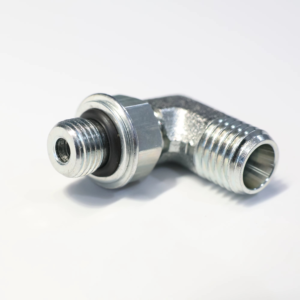Still struggling with leaking hoses and the frustration of mismatched hose fittings? Our comprehensive Hose Thread Size Chart is here to help you accurately identify the right hose and fitting for your specific needs. Whether you're working with garden hoses, pressure washers, high-pressure hydraulic hoses, or industrial hoses, you’ll find the perfect connection solution with us—precise, reliable, and tailored to your application.
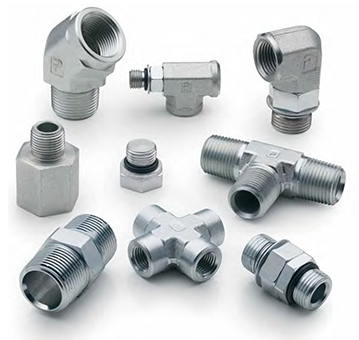
What Is a Hose Thread?
Hose threads refer to the spiral grooves found on the outer or inner surfaces of a hose or fitting. These threads play a critical role in connecting hoses and fittings, offering both mechanical grip and sealing capability. They are engineered to withstand high pressure and temperature conditions, making them suitable for a wide range of industrial and commercial applications.
Hose threads are commonly classified into three main categories:
-
Metric Threads (M)
-
Special or Customized Threads
In engineering practice, the quality of hose threads directly impacts the safety, durability, and performance of the entire piping system. This is why it's essential to follow strict manufacturing standards, use certified raw materials, and apply advanced machining technologies to ensure thread accuracy and consistency.
In summary, hose threads are a vital component in any fluid or air conveyance system, ensuring secure and leak-free connections. Both manufacturers and users must adhere to international thread standards, select high-quality products, and conduct regular inspections and maintenance to ensure system reliability and long-term performance.
At Sinopulse, we understand the importance of thread precision. That’s why we offer custom thread options and high-precision manufacturing to meet the specific demands of your system—no matter the industry or application.
Common Hose Thread Abbreviations
Understanding hose thread abbreviations is essential for selecting the correct fittings for your application. Here are the most widely used thread types and their meanings:
| Abbreviation | Full Name | Description |
|---|---|---|
| NPTF | National Pipe Tapered Fuel | A dry-seal, tapered thread commonly used in the U.S. for fuel and hydraulic applications. |
| NPSM | National Pipe Straight Mechanical | A straight-thread, mechanical seal used with O-rings or sealing washers. |
| ISO | International Organization for Standardization | International standards used globally, including metric threads. |
| SAE | Society of Automotive Engineers | Common in automotive and hydraulic systems, includes straight and O-ring boss threads. |
| JIC | Joint Industry Council | A 37° flare fitting standard, widely used in fluid power applications. |
| NFPA | National Fluid Power Association | Sets standards for fluid power components, including threads. |
| BSP | British Standard Pipe | Includes both tapered (BSPT) and parallel (BSPP) threads; common in UK, Asia, and Europe. |
| DIN | Deutsches Institut für Normung (German Industrial Standard) | German standard for metric threads and hydraulic connectors. |
| JIS | Japanese Industrial Standard | Used for metric fittings and hydraulic components in Japan. |
| BSPT | British Standard Pipe Taper | A tapered version of BSP, used for pressure-tight joints. |
| BSPP | British Standard Pipe Parallel | A straight (parallel) thread used with sealing washers or O-rings. |
At Sinopulse, we support all major thread standards and offer custom thread machining to meet your unique requirements. Whether you need NPT, BSP, JIC, or metric threads, we ensure precise compatibility and reliable sealing performance for your hydraulic and industrial hose applications.
National Pipe Tapered Fuel (NPTF) Thread
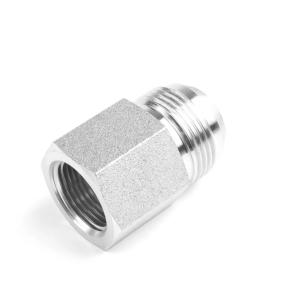
NPTF (National Pipe Tapered Fuel) threads are a standardized type of tapered pipe thread specifically designed to create leak-proof, dry-seal connections for fluids and gases—particularly fuel, oil, and hydraulic systems.
Key Features of NPTF Threads:
-
Tapered Design:
Like NPT (National Pipe Taper), NPTF threads have a tapered profile. This taper allows for a progressively tighter fit as the threads engage, improving sealing capability. -
Metal-to-Metal Sealing:
Unlike standard NPT threads, which typically require PTFE tape or thread sealant, NPTF threads are engineered to seal without additional sealing compounds. This is achieved through precision differences in the root and crest diameters, which allow for a metal-to-metal seal under torque—reducing the risk of leaks. -
Standardized Specification:
NPTF threads are governed by the ANSI B1.20.3 standard, as defined by the American National Standards Institute (ANSI). This ensures consistency and compatibility across manufacturers.
At Sinopulse, we manufacture hoses and fittings with precise NPTF threads to meet stringent sealing requirements—ensuring your fluid systems remain leak-free even under high pressure. We also offer custom thread machining for seamless integration into your existing systems.
NPTF (National Pipe Tapered Fuel) Thread Size Chart
NPTF threads are widely used in fuel lines, hydraulic systems, and high-pressure fluid applications where leak-free performance is critical. The chart below lists the most commonly used NPTF sizes, including threads per inch (TPI) and both male (OD) and female (ID) thread diameters.
| Inch Size | Dash Size | Threads Per Inch (TPI) | Male Thread OD (inches) | Female Thread ID (inches) |
|---|---|---|---|---|
| 1/16 | – | 27 | 0.3125 | 0.2611 |
| 1/8 | – | 27 | 0.405 | 0.401 |
| 1/4 | – | 18 | 0.540 | 0.534 |
| 3/8 | – | 18 | 0.675 | 0.641 |
| 1/2 | – | 14 | 0.840 | 0.821 |
| 3/4 | – | 14 | 1.050 | 1.036 |
| 1 | – | 11.5 | 1.315 | 1.291 |
| 1-1/4 | – | 11.5 | 1.660 | 1.636 |
| 1-1/2 | – | 11.5 | 1.900 | 1.876 |
| 2 | – | 11.5 | 2.375 | 2.351 |
NPSM (National Pipe Straight Mechanical) Thread
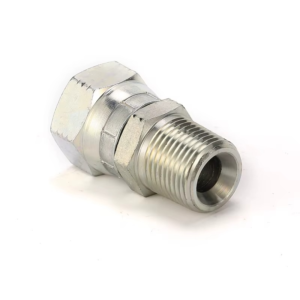
NPSM (National Pipe Straight Mechanical) threads are straight (parallel) threads designed to provide mechanical connections in piping systems. Unlike tapered threads such as NPT or NPTF, NPSM threads do not create a seal on their own and therefore require additional sealing elements—typically O-rings or washers—to prevent leakage.
Key Characteristics of NPSM Threads:
-
Mechanical Connection Only:
NPSM threads are used to form a secure mechanical joint between pipes or fittings, but they rely on external sealing components to ensure leak-free performance. -
Straight (Parallel) Thread Design:
Unlike the tapered profile of NPT threads, NPSM threads maintain a constant diameter, providing a straight-thread profile. This is especially important when precise alignment and easy assembly/disassembly are needed. -
Common in Fire Hose Applications:
NPSM shares the same threads per inch (TPI) as National Standard Thread (NST), which is commonly used in fire hose connections. For example, larger sizes typically follow 11.5 TPI, aligning with NST specifications. -
Standardized Dimensions:
The dimensional and tolerance specifications for NPSM threads are defined in the ANSI/ASME B1.20.1 standard. This includes details such as thread pitch, major diameter, and thread class fit.
At Sinopulse, we produce high-precision NPSM-threaded hose fittings and adapters for customers who require straight-thread mechanical connections with integrated O-ring or gasket seals. Whether for fire safety systems, industrial equipment, or custom assemblies, we ensure tight fitment, easy installation, and excellent durability.
NPSM (National Pipe Straight Mechanical) Thread Size Chart
The following chart provides the most commonly used NPSM thread sizes, including inch size, threads per inch (TPI), male thread outside diameter (OD), and minimum female thread inside diameter (ID).
Note: Unlike some other thread types, NPSM threads do not use dash sizes. All dimensions are specified in inches.
| Inch Size | Threads Per Inch (TPI) | Male Thread OD (inches) | Female Thread Min. ID (inches) |
|---|---|---|---|
| 1/8 | 27 | 0.397 | 0.358 |
| 1/4 | 18 | 0.526 | 0.468 |
| 3/8 | 18 | 0.662 | 0.603 |
| 1/2 | 14 | 0.823 | 0.747 |
| 3/4 | 14 | 1.034 | 0.958 |
| 1 | 11.5 | 1.293 | 1.201 |
| 1-1/4 | 11.5 | 1.638 | 1.546 |
| 1-1/2 | 11.5 | 1.877 | 1.785 |
| 2 | 11.5 | 2.351 | 2.259 |
| 2-1/2 | 8 | 2.841 | 2.708 |
| 3 | 8 | 3.467 | 3.334 |
| 4 | 8 | 4.466 | 4.333 |
| 5 | 8 | 5.528 | 5.395 |
| 6 | 8 | 6.585 | 6.452 |
JIC 37° Flare (SAE J514)
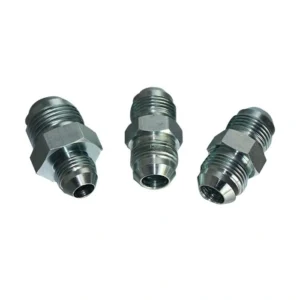
The JIC 37° Flare fitting, defined by the SAE J514 standard, is a widely used connection type in hydraulic systems. It features a 37-degree flared sealing surface, which mates with a corresponding female cone seat to form a metal-to-metal seal. The straight threads on the fitting provide mechanical retention.
Key Characteristics of JIC 37° Flare Fittings:
-
37° Flared Sealing Surface:
The male fitting is flared at a 37-degree angle, which matches the internal flare of the female fitting to create a leak-tight, high-pressure seal without the need for additional sealing compounds. -
Straight Thread Engagement:
The straight threads (UNF/UN) are used to secure the mechanical connection, while the seal is achieved by the flare interface, not the threads themselves. -
Size Identification:
JIC fittings are available in a variety of sizes and are typically identified by a dash number, which corresponds to the outside diameter (OD) of the tube in 1/16-inch increments.
For example:-
Dash 4 = 1/4" OD
-
Dash 6 = 3/8" OD
-
Dash 8 = 1/2" OD
-
At Sinopulse, we manufacture a complete line of JIC 37° flare hose fittings and adapters, precisely machined to SAE J514 standards. Our fittings are compatible with all major hydraulic systems and ensure leak-free performance even in high-vibration and high-pressure environments.
JIC 37° Flare Thread Size Chart (SAE J514)
Below is a chart of commonly used JIC 37° flare fitting sizes, including dash size, inch tube size, thread size, and the corresponding outer and inner diameters for both male and female threads. This information is essential for ensuring correct fitment and avoiding mismatches in hydraulic systems.
| Dash Size | Tube OD (inches) | Thread Size | Male Thread OD (mm) | Male Thread OD (inches) | Female Thread ID (mm) | Female Thread ID (inches) |
|---|---|---|---|---|---|---|
| -2 | 1/8 | 5/16-24 UNF* | 7.9 | 0.31 | 6.9 | 0.27 |
| -4 | 1/4 | 7/16-20 UNF* | 10.3 | 0.41 | 9.3 | 0.37 |
| -6 | 3/8 | 1/2-18 UNF* | 12.7 | 0.50 | 11.7 | 0.46 |
| -8 | 1/2 | 9/16-18 UNF* | 16.7 | 0.66 | 15.7 | 0.62 |
| -10 | 5/8 | 3/4-16 UNF* | 19.1 | 0.75 | 18.1 | 0.71 |
While most SAE J514 threads share the same thread dimensions as SAE 45° flare fittings, they are not interchangeable due to the difference in flare angle (37° vs. 45°). Using mismatched fittings may lead to leaks or fitting failure. Always verify the flare angle before assembly.
At Sinopulse, we ensure full compatibility by strictly adhering to SAE J514 specifications and offering expert guidance to help you select the correct fittings for your system.
SAE 45° Flare (SAE J512)
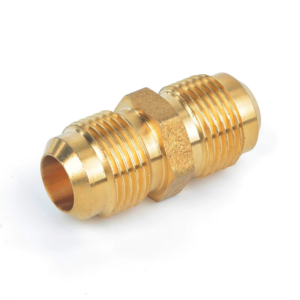
The SAE 45° Flare fitting, standardized under SAE J512, is another common connection type used primarily in low-pressure applications such as refrigerant lines and fuel systems. Similar to the JIC 37° flare, it relies on a flared sealing surface; however, the key difference lies in the flare angle—the SAE 45° flare has a 45-degree flare angle instead of 37°.
Key Information About SAE 45° Flare Thread Sizes:
-
Sizing:
SAE 45° flare fittings are typically sized using a combination of dash size and nominal tube diameter (in inches). The dash size corresponds to the outside diameter (OD) of the tube. -
Thread Specifications:
The threads on SAE 45° flare fittings conform to the Unified National Coarse (UNC) thread standard. Each fitting size corresponds to a specific UNC thread size to ensure consistent fitment.
Important: SAE 45° flare fittings are not compatible with JIC 37° flare fittings due to the difference in flare angle, even if thread sizes appear similar.
At Sinopulse, we provide a full range of SAE 45° flare hose fittings and adapters, manufactured to meet SAE J512 specifications, ensuring reliable sealing and performance in your refrigeration and fuel system applications.
SAE 45° Flare Thread Size Chart (SAE J512)
The table below summarizes common SAE 45° flare fitting sizes, including dash size, nominal tube size (inches), threads per inch (TPI), and male thread outer diameter (OD).
| Dash Size | Nominal Tube Size (inches) | Threads Per Inch (TPI) | Male Thread OD (inches) |
|---|---|---|---|
| -2 | 1/8 | 24 | 0.625 |
| -4 | 1/4 | 20 | 0.812 |
| -6 | 3/8 | 18 | 1.000 |
| -8 | 1/2 | 14 | 1.313 |
| -10 | 5/8 | 14 | 1.625 |
| -12 | 3/4 | 14 | 1.938 |
Although some SAE 45° flare thread sizes (e.g., 7/16-20, 1/2-20, 3/4-16, and 7/8-14) match those of JIC 37° flare fittings, they are not interchangeable due to the difference in flare angle (45° vs. 37°). Always ensure you select the correct fitting type for your application to prevent leaks and connection failures.
For a more detailed and comprehensive list of SAE 45° flare thread sizes and specifications, please refer to official standards such as SAE J512 or consult manufacturers’ online thread charts.
At Sinopulse, we provide a wide range of SAE 45° flare hose fittings precisely manufactured to meet SAE J512 standards, ensuring optimal performance and reliable sealing in your refrigeration, fuel, and low-pressure systems.
Different Types of Thread Representations
Understanding various thread types and their notation methods is essential for selecting the right hose and fitting connections. Below is a professional summary of common thread types, their characteristics, and how they are represented:
-
International Metric Thread System (ISO Metric Thread)
ISO Metric Thread -
Standard: China National Standard (CNS)
-
Profile: Flat thread crest and rounded root for enhanced strength
-
Thread Angle: 60°
-
Notation: Starts with “M” followed by nominal diameter and pitch, e.g., M8x1.25 (M = thread code, 8 = nominal diameter in mm, 1.25 = pitch in mm)
-
Variants: Coarse and fine threads
-
-
American Standard Thread (ASME/ANSI)
-
Profile: Flat crest and root for better strength
-
Thread Angle: 60°
-
Notation: Inch size with threads per inch (TPI), e.g., 1/2-10NC (1/2" major diameter, 10 TPI, NC = National Coarse)
-
Grades: NC (Coarse), NF (Fine), NEF (Extra Fine)
-
-
Unified Thread Standard (UTS)
-
Adopted by: USA, UK, Canada
-
Thread Angle: 60°
-
Notation: Inch size + TPI + thread series, e.g., 1/2-10UNC (Unified National Coarse)
-
Grades: UNC (Coarse), UNF (Fine), UNEF (Extra Fine)
-
-
Sharp V-Thread
-
Profile: Sharp crests and roots, weaker strength
-
Thread Angle: 60°
-
Usage: Rare due to weaker strength
-
-
Whitworth Thread
-
Standard: British Standard
-
Thread Angle: 55°
-
Notation: Begins with “W”, e.g., W1/2-10 (1/2" diameter, 10 TPI)
-
Manufacturing: Suitable for thread rolling
-
-
Knuckle Thread
-
Standard: German DIN
-
Usage: Suitable for connections like light bulbs and rubber hoses
-
Notation: “Rd”
-
-
Pipe Thread
-
Purpose: Used for gas or liquid pipe fittings to prevent leaks
-
Thread Angle: 55°
-
Types:
-
Straight Pipe Thread: “P.S.”, “N.P.S.”
-
Tapered Pipe Thread: “N.P.T.” (Taper ratio 1:16)
-
-
-
Square Thread
-
Efficiency: High transmission efficiency, second only to ball screws
-
Limitation: Cannot adjust after wear via nut
-
Usage: Vises, cranes
-
-
Trapezoidal Thread (Acme Thread)
-
Thread Angle: 30° (metric), 29° (imperial)
-
Advantages: Can be adjusted after wear via nut
-
Notation: “Tr”
-
Usage: Lathe lead screws
-
-
Buttress Thread
-
Also Called: Sawtooth thread
-
Purpose: Designed for unidirectional load transmission
-
Notation: “Bu”
-
Usage: Screw jacks, presses
-
-
Ball Screw Thread
-
Efficiency: Highest transmission efficiency
-
Usage: Precision machinery such as CNC machine tool lead screws
-
Notation: “LH” (left-hand thread), “RH” (right-hand thread, often omitted)
-
Additional Details: Includes double-start, pitch, length, thread count, and fit classes
-
Size Representation: Usually expressed as TPI (threads per inch), inverse of pitch (e.g., 8 TPI = 1/8 inch pitch)
-
Garden Hose Thread Size Chart
Garden hoses come in various inner diameters (⅜", ½", ⅝", and ¾"), but their fittings use standardized thread sizes to ensure compatibility and ease of connection.
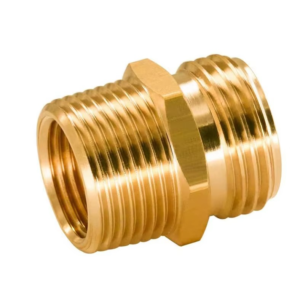
Standard Thread:
-
Name: ANSI Garden Hose Thread (GHT)
-
Specification: ¾”–11.5 NH or NHR
-
Description: This is the standard thread size for North American male (hose end) and female (coupling end) garden hose connectors.
Details:
-
Male Thread Outer Diameter: 1.0625 inches (approximately 27 mm)
-
Thread Pitch: 11.5 threads per inch (TPI)
Fire Hose Thread Size Chart
Fire hose threads are more complex than garden hose threads, with varying sizes and designs tailored for demanding applications. Below are some common categories to help you understand fire hose thread sizes:
Standard Fire Hose Thread:
-
Name: National Standard Thread (NST)
-
Description: The most common fire hose thread type in the U.S., NST is a straight (parallel) thread, unlike the tapered pipe threads used in other piping systems.
-
Sizing: Expressed by the nominal diameter of the hose, e.g., 2.5-inch NST, referring approximately to the hose’s inner diameter at the connection point.
At Sinopulse, we provide a full range of garden and fire hose fittings manufactured to meet ANSI and NST standards, ensuring secure connections and reliable performance for your watering and firefighting needs.
FAQ
Difference Between Pipe Threads and Tapered Pipe Threads
Understanding the distinction between pipe threads and tapered pipe threads is crucial for selecting the correct connections in hydraulic and piping systems. Below is a professional comparison covering their types, applications, sealing methods, and installation characteristics:
1. Definition and Thread Type
-
Pipe Thread:
Located on pipe walls, used for connections. It includes 55° non-sealing pipe threads and 55° sealing pipe threads.
Originates from the British Whitworth thread series, with thread sizes established based on the Whitworth profile.
Typically uses cylindrical (parallel) threads with a 60° thread angle. -
Tapered Pipe Thread (also called Conical Thread):
Relies on thread deformation to achieve tightness. Mainly used in pipe fittings.
Features a tapered profile where the thread diameter gradually decreases, with a 55° thread angle.
Provides a metal-to-metal seal without any filler materials by tightening the taper against a matching thread.
2. Applications
-
Pipe Threads:
Suitable for connecting parts with relatively thin walls and lower pressure requirements, such as couplings and flanges.
Easy to install, cost-effective, commonly used in low-pressure pipe connections. -
Tapered Pipe Threads:
Suitable for parts with thicker walls and higher pressure requirements, such as hydraulic systems and industrial pipelines.
Offers strong pressure resistance and reliable sealing, widely used where safety and durability are critical.
3. Sealing Mechanism
-
Pipe Threads:
Sealing occurs between the threads themselves and typically requires additional sealing measures such as tape or sealant.
The seal is dependent on the sealing agent, so reliability varies. -
Tapered Pipe Threads:
Sealing is achieved through metal-to-metal contact between the tapered surfaces of male and female threads.
This creates a self-tightening and highly reliable seal without the need for sealants.
4. Installation Method
-
Pipe Threads:
Threads are screwed in until tight, offering more installation flexibility.
In high-pressure applications, a torque wrench is often required to ensure proper tightness. -
Tapered Pipe Threads:
The tapered surfaces must be fully engaged, requiring greater installation force to achieve proper sealing.
Suitable for high-pressure systems where the joint must withstand significant forces.
Summary Table
| Aspect | Pipe Threads | Tapered Pipe Threads |
|---|---|---|
| Thread Type | Cylindrical (parallel), 60° | Tapered, 55° |
| Application | Thin-walled parts, low pressure | Thick-walled parts, high pressure |
| Sealing | Requires sealant or tape | Metal-to-metal tapered seal |
| Installation | Screwed in, flexible torque | Requires high torque for full engagement |
At Sinopulse, we produce both pipe thread and tapered pipe thread hoses and fittings, precisely manufactured to meet international standards, ensuring excellent sealing performance and durability for your specific application needs.
What Is a Threaded Hose?
A threaded hose is a type of flexible hose that uses threaded connections for attachment. This hose combines excellent flexibility and bendability, making it suitable for a wide range of complex environments.
The key feature of a threaded hose lies in its secure threaded coupling, which ensures a firm and reliable connection between pipes or fittings, effectively preventing leaks of liquids or gases.
At Sinopulse, our threaded hoses are manufactured to meet rigorous quality standards, offering customizable thread options to perfectly match your specific application requirements, ensuring both durability and leak-proof performance.
Key Considerations When Selecting Male Threaded Pipes
The specifications for male threaded pipes typically include thread size (e.g., M10, M12), thread pitch, thread length, and the outer and inner diameters of the pipe fittings. These must be carefully selected according to the specific application and hose requirements.
Important Considerations:
-
Compatibility:
Ensure the male threaded pipe fitting matches the thread specifications of the hose and connected equipment precisely. Mismatched threads can cause loose connections, leaks, or damage to the fittings. -
Material Selection:
Choose materials suitable for the operating environment and usage conditions. For example, select high-temperature-resistant or corrosion-resistant materials for harsh environments. -
Installation Torque:
Use appropriate tools and control the tightening torque during installation. Over-tightening may damage threads or deform fittings, while under-tightening can lead to loose connections. -
Inspection and Maintenance:
Regularly inspect the threaded connections to ensure they remain tight and leak-free. Replace or repair any fittings that show signs of loosening or damage promptly. -
Storage Conditions:
Store male threaded fittings in a dry, well-ventilated area to prevent moisture and corrosion. Avoid contact with sharp objects to prevent scratches or surface damage.
At Sinopulse, we emphasize strict quality control and provide detailed technical support to help you choose the right threaded fittings for your hoses, ensuring optimal performance and longevity.
Types of British Standard Pipe Threads (55° Thread Angle)
1. R Thread (Sealing Tapered Pipe Thread)
-
Characteristics:
-
55° thread angle
-
Taper ratio 1:16
-
The threaded connection itself provides sealing (metal-to-metal seal)
-
-
Applications:
-
Used for sealing pipe connections such as pipes, valves, and fittings
-
Typically requires sealing tape (PTFE tape) or sealant for enhanced leak prevention
-
-
Equivalent Standard: BSPT (British Standard Pipe Tapered)
2. G Thread (Non-Sealing Parallel Pipe Thread)
-
Characteristics:
-
55° thread angle
-
Cylindrical (parallel) thread profile, no taper
-
Requires additional sealing elements like O-rings or gaskets
-
-
Applications:
-
Easy installation
-
Suitable for low-pressure piping systems (≤10 bar), such as European low-pressure plumbing, instrumentation, and quick connectors under static or low-pressure conditions
-
3. PT/BSPT Thread (British Standard Pipe Tapered Thread)
-
Characteristics:
-
55° thread angle
-
Taper ratio 1:16
-
Part of the Whitworth thread family
-
-
Applications:
-
Widely used in Europe and Commonwealth countries
-
Suitable for medium to high-pressure systems (≤400 bar), such as gas pipelines, hydraulic systems, and marine piping
-
-
Advantages:
-
Excellent sealing performance
-
Low leakage rates
-
At Sinopulse, we offer a comprehensive range of BSPT, G, and R threaded hoses and fittings manufactured to meet stringent standards, providing you with reliable sealing and optimal performance across diverse pressure applications.
Types of American Standard Pipe Threads (60° Thread Angle)
1. NPT Thread (General Sealing Tapered Pipe Thread)
-
Characteristics:
-
60° thread angle
-
Taper ratio 1:16
-
U.S. standard thread
-
Sealing is achieved via metal-to-metal contact on the tapered thread surfaces
-
-
Applications:
-
Highly versatile, suitable for high-pressure (up to 6000 psi) and high-temperature (up to 343°C) environments
-
Widely used in North America for industries like petrochemical, water treatment, and hydraulic systems
-
-
Specifications:
-
Example marking: 3/8-18 NPT
-
Basic dimension formulas:
-
Pitch diameter D2=d2=D−0.8×PD_2 = d_2 = D - 0.8 \times P
-
Minor diameter D1=d1=D−1.6×PD_1 = d_1 = D - 1.6 \times P
-
-
Nominal sizes range from 4.102 mm (1/8") to 19.456 mm (6")
-
2. NPTF Thread (Dryseal Tapered Pipe Thread)
-
Characteristics:
-
Higher precision than NPT
-
Does not require additional sealing materials
-
Sealing achieved through interference fit of the threads (metal-to-metal dry seal)
-
-
Applications:
-
Used in demanding environments requiring strict leak prevention, such as aerospace and special equipment
-
3. NPSM Thread (Straight Mechanical Pipe Thread)
-
Characteristics:
-
Straight (cylindrical) thread design
-
Intended for mechanical connections without pressure sealing requirements
-
-
Applications:
-
Equipment connections where free fitting, easy installation, and disassembly are needed
-
At Sinopulse, our American standard threaded hoses and fittings meet precise manufacturing tolerances and industry standards, ensuring high performance and reliable sealing across diverse industrial applications.
Types of Metric Pipe Threads (60° Thread Angle)
Metric Threads
-
Types:
-
Sealing (M) threads
-
Non-sealing (M) threads
-
-
Applications:
-
Mainly used in Europe and regions adopting the metric system standards
-
-
Characteristics:
-
Thread angle of 60°
-
Manufactured according to metric specifications, available in both sealed and non-sealed forms to suit different pressure and sealing requirements
-
At Sinopulse, we offer a full range of metric threaded hoses and fittings, precisely engineered to meet international metric standards, ensuring compatibility and reliable sealing for your applications.
Conversion Table for 55° Parallel (Cylindrical) Pipe Threads Across Different Countries
The 55° parallel pipe thread, originating from the inch-based Whitworth series, is widely used in both metric and imperial standard countries. It is primarily utilized for connecting pipe fittings and tubes to convey liquids and gases, as well as for wiring installations. However, thread designations vary by country, so it’s important to refer to the conversion table below for accurate identification.
| Country | Thread Designation |
|---|---|
| China | G |
| Japan | G, PF |
| United Kingdom | BSP, BSPP |
| France | G |
| Germany | R (internal thread), K (external thread) |
| Former USSR | G, ТРУБ (TRUB) |
| ISO Standard | Rp |
At Sinopulse, we manufacture hoses and fittings compatible with a wide range of international thread standards, ensuring seamless integration regardless of regional specifications.
Conversion Table for 55° Tapered Pipe Threads Across Different Countries
The 55° tapered pipe thread, characterized by a 55° thread angle and a taper ratio of 1:16, is widely used globally. However, thread designations vary by country, so appropriate conversions are necessary for international communication and cooperation. Below is the comparison of designations used by various countries for 55° tapered pipe threads.
| Country | Thread Designation |
|---|---|
| China | ZG, R (external thread) |
| United Kingdom | BSPT, R (external thread), Rc (internal thread) |
| France | G (external thread), R (external thread) |
| Germany | R (external thread) |
| Japan | PT, R |
| ISO Standard | R (external thread), Rc (internal thread) |
At Sinopulse, we produce hoses and fittings that adhere to these international standards, providing you with reliable, compatible solutions for global applications.
Conversion Table for 60° Tapered Pipe Threads Across Different Countries
The 60° tapered pipe thread, featuring a 60° thread angle and a 1:16 taper, is widely used in China’s machine tool industry as well as in the United States and the former Soviet Union. The designation in China has evolved over time—from K (old) to Z, and now standardized as NPT. Below is the comparison of thread designations used in different countries for 60° tapered pipe threads.
| Country | Thread Designation |
|---|---|
| China | Z (old), NPT (new) |
| United States | NPT |
| Former USSR | B |
At Sinopulse, we specialize in manufacturing hoses and fittings with precise thread profiles matching these standards, ensuring reliable sealing and compatibility in various industrial applications worldwide.
Conversion Table for 55° Trapezoidal Threads Across Different Countries
The trapezoidal thread, characterized by a 55° thread angle, is a type of metric thread. This series of threads is relatively consistently used both domestically and internationally, and the designations are also fairly unified. Below is the comparison of 55° trapezoidal thread designations used in various countries.
| Country | Thread Designation |
|---|---|
| China | T (old), Tr (new) |
| ISO Standard | Tr |
| Germany | Tr |
| Former USSR | Tr |
Differences Between NPT, PT, and G Pipe Threads
Sealing Mechanism Differences
-
NPT Thread:
Seals via metal-to-metal contact on the tapered thread surface, similar to two tough hands tightly gripping each other. It offers excellent pressure resistance (0–6000 psi) and an extremely low leakage rate. -
PT Thread:
Utilizes a 55° thread angle and taper to form multiple line contacts for sealing. When combined with PTFE tape, it achieves sealing pressures up to 400 bar with an even lower leakage rate, making it a top performer in sealing applications. -
G Thread:
A non-sealing parallel thread requiring additional sealing elements such as O-rings, composite gaskets, or anaerobic sealants. Suitable for low-pressure (≤10 bar) static applications, but with relatively higher leakage rates.
Sealing Performance Verification
-
NPT Thread:
Verified using helium mass spectrometry leak detection at 200 bar pressure, maintained for 30 minutes, achieving a leakage rate ≤ 1×10⁻⁹ Pa·m³/s, demonstrating outstanding sealing reliability. -
PT Thread:
Tested under hydrostatic pressure at 1.5 times the working pressure, maintained for 15 minutes with no visible leakage, ensuring safety and reliability. -
G Thread:
Tested under pneumatic pressure at 1.1 times the working pressure, maintained for 10 minutes with no bubbles detected by soap water, effectively handling low-pressure environments.
Typical Applications
-
Petrochemical Industry
-
NPT: High-temperature crude oil pipelines in refineries, operating between -29℃ and 343℃, complying with API 6A sealing standards.
-
PT: Ultra-low temperature LNG transport pipelines on ships, using 316L stainless steel, thread gap ≤ 0.1mm, certified by DNV GL.
-
G: Low-pressure steam pipelines in chemical parks, working at 1.6 MPa, using EPDM rubber gaskets, certified under GB/T 18742.2.
-
-
Gas Equipment
-
NPT: North American natural gas pressure regulation stations, 1/2-14 NPT thread connecting DN15 pipelines, working pressure 200 psi, sealed with Loctite 577.
-
PT: European gas water heaters, Rc 1/2 thread connecting DN15 inlet pipes, working pressure 0.5 bar, using nitrile rubber O-rings, certified to EN 16436.
-
G: Industrial gas alarms, G 1/4 thread connecting DN8 signal pipes, working pressure 0.1 bar, equipped with fluororubber O-rings, protection level IP67.
-
-
Hydraulic Systems
-
NPT: Hydraulic pipelines in construction machinery, 1/2-14 NPT fittings connected to SAE 100R2 steel wire braided hoses, working pressure 350 bar.
-
PT: Ship hydraulic rudders, Rc 3/4 thread connecting DN20 pipelines, working pressure 210 bar, sealed with PTFE tape, certified by ABS.
-
G: Hydraulic test bench quick couplers, G 1/2 thread connecting DN15 pipelines, working pressure 25 bar, reusable ≥ 500 times, leakage ≤ 0.1 ml/min.
-
-
Waterworks Engineering
-
NPT: North American water supply systems, 3/4-14 NPT thread connecting DN20 ductile iron pipes, working pressure 16 bar, sealed with PTFE tape, meeting AWWA C800 standards.
-
PT: UK sewage treatment plants, Rc 1-inch thread connecting DN25 pipelines, working pressure 10 bar, sealed with anaerobic glue, WRAS certified.
-
G: Chinese residential water supply pipes, G 1/2 thread connecting PPR pipes, working pressure 1.6 MPa, using EPDM rubber gaskets, certified to GB/T 18742.2.
-
How to Choose
-
Working Pressure:
For pressures above 10 bar, prefer NPT or PT threads; for pressures ≤ 10 bar without vibration, G threads are a suitable choice. -
Medium Characteristics:
For corrosive media, stainless steel PT threads are recommended; for high-temperature media (>200℃), choose alloy steel NPT threads to ensure safety and reliability. -
Installation Space:
For confined spaces, G threads with quick couplers are preferred; for high-pressure conditions, NPT or PT threads ensure stable connections. -
Maintenance Requirements:
For frequent disassembly, G threads with O-rings offer ease of maintenance; for long-term service, NPT/PT threads combined with sealants provide more durable sealing performance.
Difference Between NPSM and G Threads
NPSM stands for the American standard Non-Pressure Straight Mechanical thread, characterized by a 60° thread angle. Besides NPSM, there are three other types of American non-sealing straight threads: NPTR (rail taper thread), NPSL (locknut straight thread), and NPSH (hose coupling straight thread). All of these share the 60° thread angle.
G thread is the designation for British standard non-sealing parallel pipe thread, featuring a 55° thread angle.
Differences Between NPT and G Threads
1. American Standard Thread NPT (60°):
NPT stands for National (American) Pipe Thread. It is a 60° tapered pipe thread standard used primarily in North America, with a taper ratio of 1:16. The size markings such as 1/4, 1/2, and 1/8 indicate the nominal diameter of the thread in inches. Industry professionals often refer to these sizes using "分" (fen), where one inch equals 8 fen, so 1/4 inch corresponds to 2 fen, and so on.
2. British Standard Parallel Pipe Thread G (55°):
G represents a 55° parallel (straight) pipe thread, belonging to the Whitworth thread family. The “G” designation refers to a cylindrical (parallel) thread. The corresponding Chinese national standard is GB/T 7307-2001. Similarly, the size markings such as 1/4, 1/2, and 1/8 indicate nominal diameter in inches, with professionals also using “fen” for size reference.
Thread Structure Classification
Threads can be classified by their cross-sectional profile (thread form) into triangular, square, trapezoidal, and buttress threads. Among these, triangular threads are mainly used for connections, while square, trapezoidal, and buttress threads are used for power transmission. Threads formed on the external surface of a component are called external threads, whereas those on the internal surface are internal threads.
Differences between G Thread and M Thread
-
Different Units
G represents the British Standard Pipe Thread, with a 55° thread angle. Dimensions such as major diameter, minor diameter, and threads per inch (TPI) are marked in imperial units (inches).
M represents the Metric general-purpose thread, with a 60° thread angle. All dimensions are in metric units (millimeters). -
Different Sealing Characteristics
G thread refers to non-sealing pipe threads: it has a 55° thread angle, and both internal and external threads are cylindrical. When mated, it does not provide a seal by itself and serves only as a connection. Sealing is achieved by using sealing rings such as O-rings, suitable for low-pressure static applications. The thread crests and roots are rounded.
M thread refers to pipe threads that provide sealing via the threads themselves: it has a 55° thread angle and a taper of 1:16. After tightening, it achieves a seal. The crests and roots of the thread are also rounded. There are two types of fits.
How to Properly Choose Hose Threads
-
Sealing Requirements:
Prefer tapered threads (such as NPT, Rc) combined with PTFE tape for sealing; for high sealing demands, NPTF is recommended. -
Pressure Rating:
For high pressure, choose NPT or NPTF; for low pressure, select G or NPSM threads. -
Regional Standards:
Use NPT in North America; use R or G threads in Europe and China.
How to Confirm Thread Requirements When Purchasing Hoses and Fittings
When buying hoses and fittings, especially from a professional supplier, they can usually identify the required thread type by examining physical samples or structural drawings. To ensure you get the most suitable hose, it is best to provide the supplier with:
-
Clear photos or diagrams of the thread
-
The exact thread specifications (e.g., M16×1.5 or G1/2)
-
The sealing type required (such as tapered seal, tongue-and-groove seal, etc.)
-
Pressure ratings and the type of medium (fluid or gas) involved
-
A detailed description of your application scenario
Providing this information will help the supplier respond quickly and accurately with products that perfectly match your needs.
For reliable, high-quality hoses and fittings, consider sourcing from Sinopulse, a professional hose manufacturer with extensive experience in delivering customized hydraulic and industrial hose solutions worldwide. Contact Sinopulse now!
